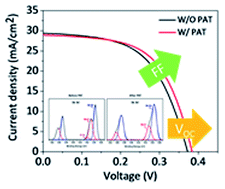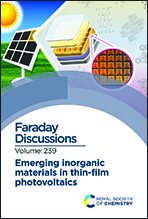Comprehensive rear surface passivation of superstrate Sb2Se3 solar cells via post-deposition selenium annealing treatments and the application of an electron blocking layer†
Abstract
Sb2Se3, a quasi-1D structured binary chalcogenide, has great potential as a solar cell light absorber owing to its anisotropic carrier transport and benign grain boundaries when the absorber layer is properly aligned along the [hk1] direction perpendicular to the substrate. A growth technique with a high deposition rate, such as vapor transport deposition, is preferred to form an [hk1]-oriented Sb2Se3 film. However, the possible decomposition of Sb2Se3 during cooling after the high-temperature deposition appears to result in Se deficiency, accompanied by the formation of deep-level donor-like defects, such as Se vacancies and Sb on Se antisite defects. Here, we present comprehensive passivation strategies for the rear interface of Sb2Se3 solar cells in a superstrate configuration, namely a post-deposition annealing treatment (PAT) under Se, and the introduction of an electron-blocking layer between Sb2Se3 and the rear metal contact. The PAT effectively passivated the defects associated with Se deficiency and greatly improved the open-circuit voltage and fill factor of Sb2Se3 solar cells. With the further introduction of a poly(N,N-bis(4-butylphenyl)–N,N-bis(phenyl)benzidine) electron-blocking layer, the Sb2Se3 solar cell achieved an efficiency of 7.0%.

- This article is part of the themed collection: Emerging inorganic materials in thin-film photovoltaics


 Please wait while we load your content...
Please wait while we load your content...